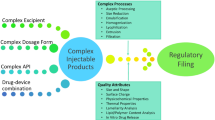Abstract
The objective of this study was to develop an authentic ionic-driven osmotic pump system and investigate the release mechanism, simultaneously exploring the in vitro and in vivo correlation of the ionic-driven osmotic pump tablet. A comparison of the ionic-driven and conventional theophylline osmotic pump, the influence of pH and the amount of sodium chloride on drug release, the relationship between the ionic osmotic pressure and the drug release, and the pharmacokinetics experiment in beagle dogs were investigated. Consequently, the similarity factor (f 2 ) between the novel and conventional theophylline osmotic pump tablet was 60.18, which indicated a similar drug-release behavior. Also, the release profile fitted a zero-order kinetic model. The relative bioavailability of the ionic-driven osmotic pump to the conventional osmotic pump calculated from the AUC (0-∞) was 93.6% and the coefficient (R = 0.9945) confirmed that the ionic-driven osmotic pump exhibited excellent IVIVC. The driving power of the ionic-driven osmotic pump was produced only by ions, which was strongly dependent on the ion strength, and a novel formula for the ionic-driven osmotic pump was derived which indicated that the drug-release rate was proportional to the ionic osmotic pressure and the sodium chloride concentration. Significantly, the formula can predict the drug-release rate and release characteristics of theophylline ionic-driven osmotic pumps, guiding future modification of the ionic osmotic pump.






Similar content being viewed by others
REFERENCES
Rose S, Nelson J. A continuous long-term injector. Aust J Exp Biol Med Sci. 1955;33:415–9.
Hill A, Geissler S, Weigandt M, Mader K. Controlled delivery of nanosuspensions from osmotic pumps: zero order and non-zero order kinetics. J Control Release: Off J Control Release Soc. 2012;158:403–12. https://doi.org/10.1016/j.jconrel.2011.12.005.
Higuchi T. Improved osmotic dispenser employing magnesium sulfate and magnesium chloride, US patent 3760804 1973.
Theeuwes F. Osmotically powered agent dispending device with filling means, US patent 3760984 1973.
Xu H, et al. A novel bi-layer ascending release osmotic pump tablet: in vitro investigation and in vivo investigation in pharmacokinetic study and IVIVC evaluation. Int J Pharm. 2013;458:181–7. https://doi.org/10.1016/j.ijpharm.2013.09.031.
Theeuwes F. Elementary osmotic pump. J Pharm Sci. 1975;64(12):1987–91.
Li XD, Pan WS, Nie SF, Wu LJ. Studies on controlled release effervescent osmotic pump tablets from Traditional Chinese Medicine Compound Recipe. J Control Release: Off J Control Release Soc. 2004;96:359–67. https://doi.org/10.1016/j.jconrel.2004.01.026.
Patel H, Patel U, Kadikar H, Bhimani B, Daslaniya D, Patel G. A review on osmotic drug delivery system. Int Res J Pharm. 2012;3(4):89–94.
Sahoo CK, Sahoo NK, Rao SRM, Sudhakar M, Satyanarayana K. A review on controlled porosity osmotic pump tablets and its evaluation. Bull Fac Pharm, Cairo Univ. 2015;53:195–205. https://doi.org/10.1016/j.bfopcu.2015.10.004.
Barnes PJ. Theophylline. Am J Respir Crit Care Med. 2013;188:901–6. https://doi.org/10.1164/rccm.201302-0388PP.
Lizhen C, Xiumei G, Haoyang W, et al. Aqueous polymer dispersion coating used for osmotic pump tablets: membrane property investigation and IVIVC evaluation. AAPS PharmSciTech. 2017; https://doi.org/10.1208/s12249-017-0837-7.
Kai C, Yanyan W, Xiumei G, et al. Design of a time-controlled pulsatile release system for propranolol using the dry-coated method: in vitro and in vivo evaluation. AAPS PharmSciTech. 2017; https://doi.org/10.1208/s12249-017-0746-9.
Saeed S, Parastou E, Ahmad M, Yemisi R, Alusine D, Waseem K, et al. Investigation on the effect of polyethylene oxide concentration and particle size in modulating theophylline release from tablet matrices. AAPS PharmSciTech. 2015; https://doi.org/10.1208/s12249-015-0295-z.
National Pharmacopoeia Committee. Pharmacopoeia of People’s Republic of China [M]. Part 4. Beijing: Chemical Industry Press; 2015. p. 367.
Yueqi BI, Zhang Y, Hou S. A controlled porosity osmotic pump system with biphasic release of theophylline: influence of weight gain on its in vivo pharmacokinetics. Chem Pharm Bull. 2008;56(6):792–5.
Hayashi T, et al. In vitro and in vivo sustained-release characteristics of theophylline matrix tablets and novel cluster tablets. Int J Pharm. 2007;341:105–13. https://doi.org/10.1016/j.ijpharm.2007.03.048.
El-Bagory I, Barakat N, Ibrahim MA, El-Enazi F. Formulation and in vitro evaluation of theophylline matrix tablets prepared by direct compression: effect of polymer blends. Saudi Pharm J: SPJ: Off Publ Saudi Pharm Soc. 2012;20:229–38. https://doi.org/10.1016/j.jsps.2011.11.007.
Jerzewski RL, Chien YW. Osmotic drug delivery. In: Kydonieus A, editor. Treatise on controlled drug delivery: fundamentals, optimization, application. New York: Marcel Dekker; 1992. pp. 2225–53.
Shah N, Patel N, Patel KR. A review on oral osmotic ally controlled released drug delivery system. J Pharm Sci Biosci Res. 2012;2(5):230–37.
Verma RK, Krishna DM, Garg S. Formulation aspects in the development of osmotically controlled oral drug delivery systems. J Control Release. 2002;79:7–27.
Missaghi S, Patel P, Farrell TP, Huatan H, Rajabi-Siahboomi AR. Investigation of critical core formulation and process parameters for osmotic pump oral drug delivery. AAPS PharmSciTech. 2014;15:149–60. https://doi.org/10.1208/s12249-013-0040-4.
Jian H, Zhu L, Zhang W, Sun D, Jiang J. Galactomannan (from Gleditsia sinensis Lam.) and xanthan gum matrix tablets for controlled delivery of theophylline: in vitro drug release and swelling behavior. Carbohydr Polym. 2012;87:2176–82. https://doi.org/10.1016/j.carbpol.2011.10.043.
Moore JW, Flanner HH. Mathematical comparison of dissolution profiles. Pharm Technol. 1996;20(6):64–74.
Chai Y. Analytical Chemistry (M) 6th ed. People’s Health Publishing press. 2016 ISBN:9787117223652.
Fernandez-Campos F, Ferrero C, Colom H, Jimenez-Castellanos MR. Invivo absorption behaviour of theophylline from starch-methyl methacrylate matrix tablets in beagle dogs. Int J Pharm. 2015;478:684–92. https://doi.org/10.1016/j.ijpharm.2014.11.071.
Mohanty S, Sahu M, Sirisha A. Osmotic pump a novel approach to control drug delivery. Indo Am J Pharm Res. 2014;4(05):2367–73.
Li S et al. Physical Chemistry, 7th ed. People’s Health Publishing press;2011. ISBN 978–7–117-14395-0.
ACKNOWLEDGEMENTS
This work was supported by the program of supporting career development of young and middle-aged teachers from Shenyang Pharmaceutical University (ZQN2015011).
Author information
Authors and Affiliations
Corresponding author
Ethics declarations
All animal experiments were conducted in accordance with the principles of Laboratory Animal Care and approved by Shenyang Pharmaceutical University Animal Ethical Committee, and the ethical committee approval number of animal studies is SYPU-IACUC-2017-1210-501.
Rights and permissions
About this article
Cite this article
Cheng, L., Gao, S., Ouyang, D. et al. Release Mechanism Between Ion Osmotic Pressure and Drug Release in Ionic-Driven Osmotic Pump Tablets (I). AAPS PharmSciTech 19, 803–811 (2018). https://doi.org/10.1208/s12249-017-0900-4
Received:
Accepted:
Published:
Issue Date:
DOI: https://doi.org/10.1208/s12249-017-0900-4




